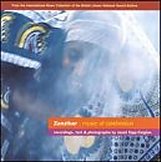 Zanzibar: Zanzibar:Music of Celebration Topic Records
TSCD917. From the International Music Collection of the British Library National Sound
Archive. Compact disc, 64 minutes. Liner notes: 14 pages, text, and photographs by Janet
Topp Fargion. Producer: Tony Engle. Photos, map. |
|
The outstanding recordings
that comprise this CD were made by Janet Topp Fargion, Curator of the IMC, during her
period of doctoral fieldwork in 1989 and 1990. The CD booklet features photographs, liner
notes, and individual track descriptions, all also contributed by Fargion. The CD
packaging is attractive and the front cover photograph of a woman at a wedding (dancing?)
with incense evokes the energy and excitement of the taarab dance music that makes
up the majority of the CD’s eight tracks. Taarab is a style of music played for entertainment at weddings and other festivities all along the Swahili coast of East Africa. The word taarab also refers to the events at which this style of music is played, which are usually weddings but also include paid-admission concerts. This CD features three types of taarab that are played on the island of Zanzibar:
Though not listed separately
as a type of taarab, the CD also includes what Fargion calls “Indian
taarab”—taarab played by members of the Zanzibari Indian community that is
markedly Indian-influenced. Finally, the CD also features two selections of maulidi,
a genre associated with the festivity celebrating the birth of Mohammed (though performed
at many other occasions). The introductory liner notes offer concise but effective discussions of the history of taarab, relevant general history of Zanzibar, and the contexts, performers and musical/cultural influences of each of the individual tracks. Individual track descriptions list the song title, date and location of the recording, and, in some cases, featured performers and/or composers. Some individual track descriptions also include lyrics or supplemental information. Inclusion of more in-depth, contextual detail about each track in the individual track descriptions would have improved the overall presentation of information; as is, listeners must leaf through the general liner notes to find information that aids understanding of individual tracks. Still, the body of information available in the CD booklet enriches the experience of listening to the selections immensely. The liner notes are particularly strong at relating aspects of the music sound to contextual and historical information. Taarab has been transnational in nature since its arrival in Zanzibar in the nineteenth century, when the island became a seat in the Omani Sultanate and Egyptian music became popular at entertainment events. |
|
(Note: Audio examples 1,2 and 4 begin soft and then grow in volume.) |
Listening to the tracks of orchestral taarab (Audio 1), the influence of Egyptian music is clearly evident in terms of aesthetics, form and instrumentation (udi, kanuni, riqq, darabukka and violins). Transnationalism continues today in “Indian taarab” (Audio 2). This is taarab played by members of the Zanzibari Indian community who frequently borrow melodies and rhythms of Indian film songs, write new texts in Swahili and sometimes accompany their songs with harmonium and tabla (often replaced by bongos). Local, distinctively sub-Saharan African music influences also pervade taarab. Local music is particularly evident in the kidumbak example (Audio 3), a style that originated in outlying areas of Zanzibar Town, where African musicians adapted orchestral taarab repertoire to local aesthetics, using home-made instruments, faster tempos, and local rhythms and lyrical approaches. Kidumbak in turn influences orchestral taarab, which today frequently features both “traditional” taarab rhythms and those of local origin (Audio 4). |
Overall, the liner notes succeed in making this package both more enjoyable and more educational. With notes in hand, the listener can easily appreciate the variety of performance styles and their connection to the “ethnic, religious and gendered composition of this island culture” (liner notes, p. 3). While ethical and legal issues associated with copyright, and lack of funding, frequently limit what sound archives can do with their holdings, it would be a shame if scholars and music aficionados were denied access to fine recordings such as this. One can only hope that the IMC will continue to pursue the worthy mission of making the riches in their collections available to the general public. finalized 28 August, 2001 review
| review index | EOL 7 |
|